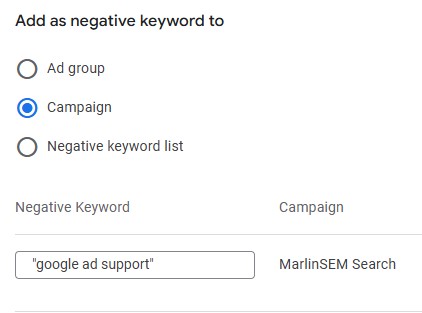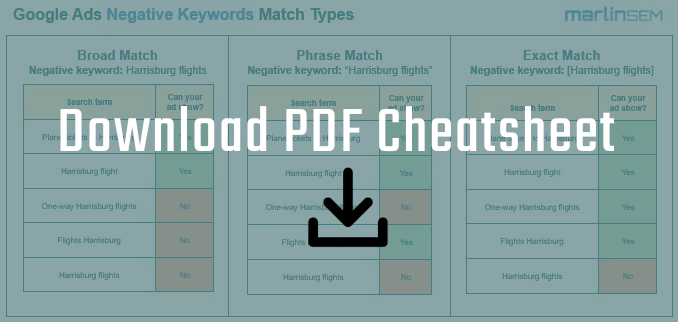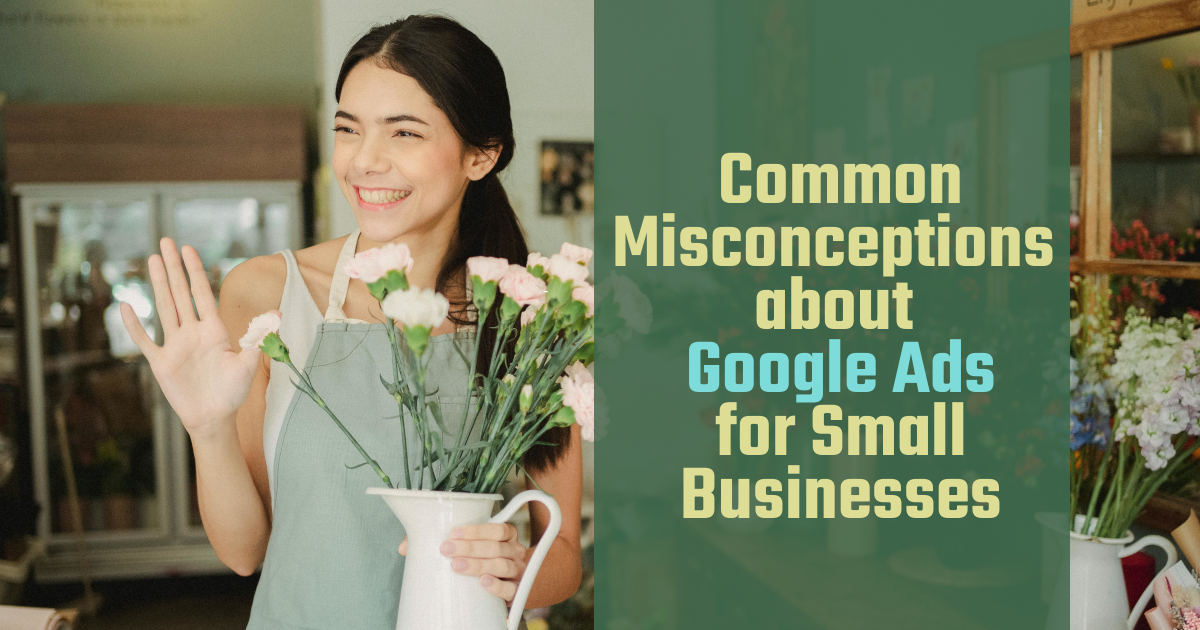In Google Ads, choosing negative keyword match types is not always intuitive. That’s partly because the negative match types don’t function the same as their positive counterparts.
In this post, I explain how they work and provide examples to help you know how and when to use them.
Printable Cheat Sheet (PDF): Negative Keyword Match Types
In a hurry? Print this free cheat sheet (PDF download) and keep it on your desk.
Broad match negative keyword: Harrisburg flights
(Most restrictive. Blocks any phrase incorporating that exact term, including when the words are reversed.)
Search term |
Can your ad show? |
|---|---|
| Plane tickets to Harrisburg | Yes |
| Harrisburg flight | Yes |
| One-way Harrisburg flights | No |
| Flights Harrisburg | No |
| Harrisburg flights | No |
Notice how the singular “Harrisburg flight” can still trigger your ad. Also, the reverse word order “Flights Harrisburg” would be blocked, according to Google.
Phrase match negative keyword: “Harrisburg flights”
(Less restrictive. Blocks most phrases incorporating that exact term.)
Search term |
Can your ad show? |
|---|---|
| Plane tickets to Harrisburg | Yes |
| Harrisburg flight | Yes |
| One-way Harrisburg flights | No |
| Flights Harrisburg | Yes |
| Harrisburg flights | No |
Notice how the reverse word order “Flights Harrisburg” would not be blocked in this case.
Exact match negative keyword: [Harrisburg flights]
(Least restrictive. Only blocks the exact term.)
Search term |
Can your ad show? |
|---|---|
| Plane tickets to Harrisburg | Yes |
| Harrisburg flight | Yes |
| One-way Harrisburg flights | Yes |
| Flights Harrisburg | Yes |
| Harrisburg flights | No |
Notice how only the exact search for “Harrisburg flights” is blocked. Any other word order, or variation incorporating additional words, can still trigger your ad.
What match type should negative keywords be?
In Google Ads, negative keyword match types should be selected based on how you want to block your ads from appearing for variations of unwanted searches. Depending on the goal, the match type for your negative keyword should be:
- Negative broad match: to block searches that contain your full negative keyword term, including when the term is in a different order or has additional words tacked on.
- Negative phrase match: to block searches that contain your full negative keyword term in the same order you specified, including when the term has additional words tacked on.
- Negative exact match: to block searches that contain your full negative keyword term in the same order you specified, exactly as you’ve entered it without any extra words added by the searcher.
Natural confusion with negative keyword match types

Choosing negative keyword match types is not especially intuitive. I’ve been using Google Ads for over 15 years, and I sometimes still forget which match types to use – in part because the negative match types don’t function the same as their positive counterparts.
So I’m constantly revisiting Google’s documentation about negative keywords to remember how to use them correctly. (That’s why I created the cheat sheet above – very handy!)
Example
For regular (targeted) keywords in Google, selecting a match type helps to control how large of a net is cast for different user searches, based on the underlying intent (or the meaning of those words).
For example, if your target keyword is “Harrisburg flights” (phrase match), the following searches might trigger your ad:
- flights to Harrisburg
- flights from Harrisburg
- MDT airlines
- flights deals central Pennsylvania
- Nonstop MDT to Ohare
That’s just a few examples. With phrase match, lots of other searches can trigger your ads if those searches “include the same meaning of your keyword,” as Google puts it. (Broad match loosens that targeting even further, to capture a much wider net of search queries. And exact match tightens it.)
See the difference?
In contrast, a negative phrase match keyword for “Harrisburg flights” would only block searches that contain the phrase “Harrisburg flights.” It would not block searches that share a similar meaning, such as “flights Harrisburg.”
In short,
- Positive keyword match types control your keyword targeting by meaning.
- Negative keyword match types control your search term blocking by keywords.
In Google Ads, you can’t use negative keywords to block queries from triggering your ad based on meaning. (I wish you could.) You can only block those queries based on how they incorporate the actual words in your negative keywords.
By the way, this a good reminder to check your Search Terms data constantly, to make sure you’re not wasting money on unwanted clicks for irrelevant searches. Your Search terms report is a goldmine of potential negative keywords (and you can add them directly from that screen).
Tips for using negative keywords in Google Ads
Since you can’t use negative keywords to block large swaths of searches based on meaning, adding them can be labor-intensive. However, there are a few ways to make this process more efficient.
- Block many keyword variations at once by using a short broad or phrase match negative keyword. This will block all searches containing any instance of that word.
- For example, if you don’t want your ads to appear for any search containing “Lancaster” (such as “flights to Lancaster,” “Lancaster flights to PHL,” etc.), then you would add a broad match negative for simply “Lancaster.”
- Use negative keyword lists to apply your negative keywords across multiple ad groups or campaigns. If you have more than one campaign, then this will prevent you from having to add negatives manually to each campaign.
- To create a negative keyword list, go to Tools
 > Shared library > Exclusion lists (After adding your keywords, be sure to Apply that list to your applicable campaigns.)
> Shared library > Exclusion lists (After adding your keywords, be sure to Apply that list to your applicable campaigns.)
- To create a negative keyword list, go to Tools
- Add negative keywords at the Account Level, when applicable. Personally, this my preferred method. And, it’s especially useful for adding negative keywords to Performance Max campaigns, which otherwise have limited options for adding negatives. This can be done by going to Admin > Account settings > Negative keywords.
Why use negative keywords at all?
In short, negative keywords save you money. By blocking irrelevant searches, you avoid wasting money on unwanted clicks.

Adding negative keywords is arguably one of the most effective ways to optimize your Google Ads campaigns and prevent wasted ad spend. The more you can prevent wasted clicks, the farther your ad budget will go. (Fewer bad clicks = more budget for clicks that convert.)
Negative keyword example:
We sometimes use Google Ads to advertise our services here at MarlinSEM. Naturally, some of our target keywords are phrases like “Google Ads management,” and “Google Ads help.” But we noticed our ads started showing for searches for “Google Ads support.” That’s a very different intent (somebody trying to contact Google’s Support teams, not somebody looking for PPC management services).
We don’t want those clicks. So we added “Google Ads support” as a negative keyword (phrase match). Here’s what it looks like in Google Ads:

This prevents all searches that contain “Google Ads support” from triggering our ads, including longer variations like “How to contact Google Ads support,” “Google Ads support phone number,” and so on.
Also, remember that you can use the following notations to specify match type when you enter the negative:
- Brackets for Exact match: [Harrisburg airport]
- Quotation marks for Phrase match: “Harrisburg airport”
- No punctuation for Broad match: Harrisburg airport
Frequently Asked Questions
1. What are negative keywords in Google Ads?
In Google Ads, negative keywords are used to prevent your ads from showing for irrelevant searches. Adding negative keywords helps to block words or phrases from triggering your ads, so that you don’t waste money on an unwanted click.
2. What is a negative keyword match type in Google Ads?
In Google Ads, a negative keyword match type controls how strictly a search containing certain words should be blocked from triggering your ads. The three match type options are: Exact match (blocks only the exact phrase you specify), Phrase match (blocks any search containing the phrase you specify, in that same word order), and Broad match (blocks all searches containing the phrase you specify, in any word order).
3. How to add a negative keyword in Google Ads?
To add a negative keyword in Google Ads, go to Campaigns ![]() > Assets > Search keywords, and select the tab for Negative search keywords. Click the blue (+) button and enter your negative keywords one per line. Use the “Add to” dropdown to specify which campaign, ad group or list the negative keywords should be added to, and click Save.
> Assets > Search keywords, and select the tab for Negative search keywords. Click the blue (+) button and enter your negative keywords one per line. Use the “Add to” dropdown to specify which campaign, ad group or list the negative keywords should be added to, and click Save.
Conclusion
Negative keyword match types in Google Ads don’t work like their positive counterparts. So you need to be sure you’re using the right match types to effectively block the searches you don’t want to trigger your ads. Use the cheat sheet above as a handy reference for which match types to use and how they work.
Need some help?
Adding negative keywords is only one of many important strategies for maximizing the results of a Google Ads campaign. To learn how we can improve your results, request pricing for hands-on account management, or email me at mike@marlinsem.com.






![How to Use Google Ads for Limo Services [Updated 2025]](https://marlinsem.com/wp-content/uploads/2024/01/limo-company-advertising-google-ads-2025.png)

